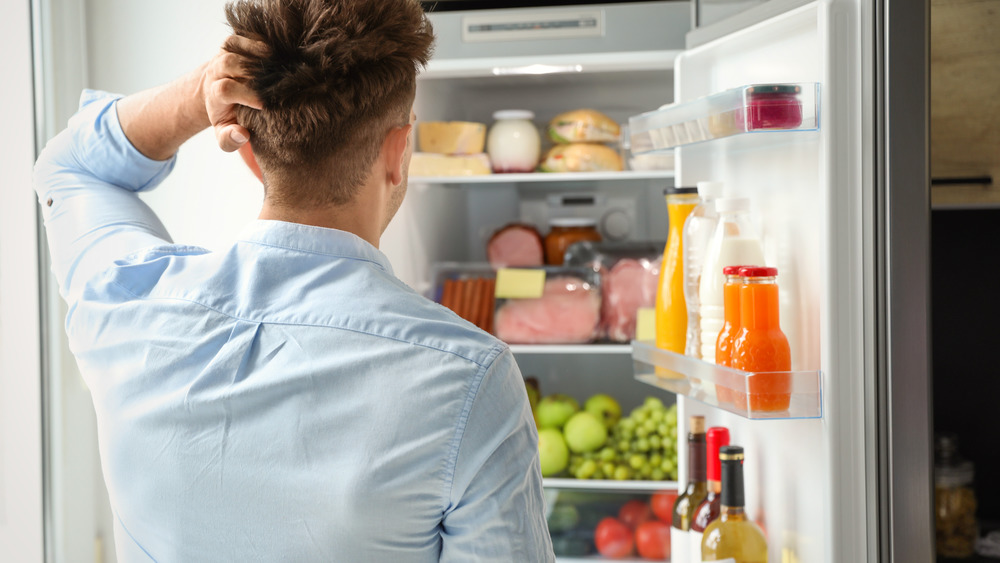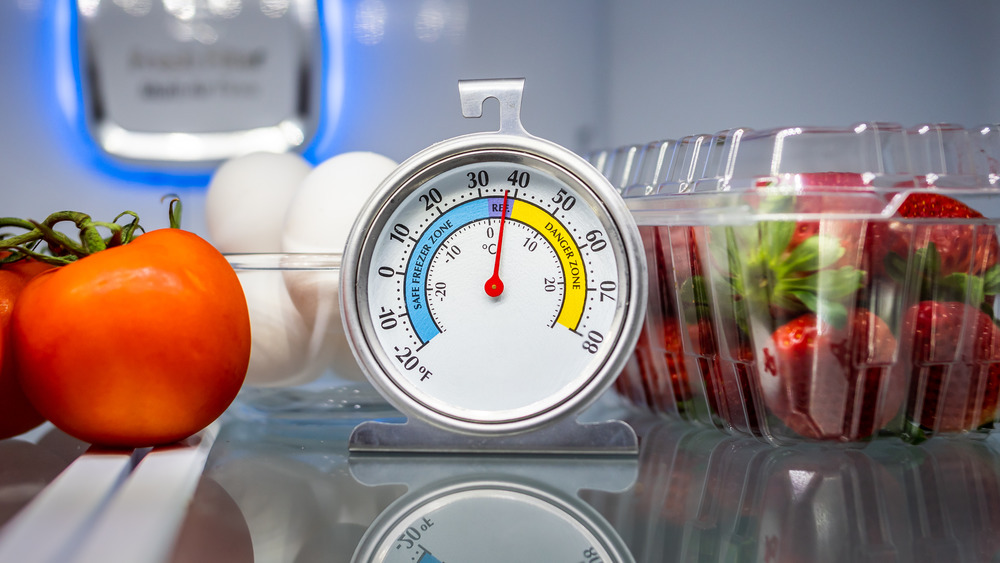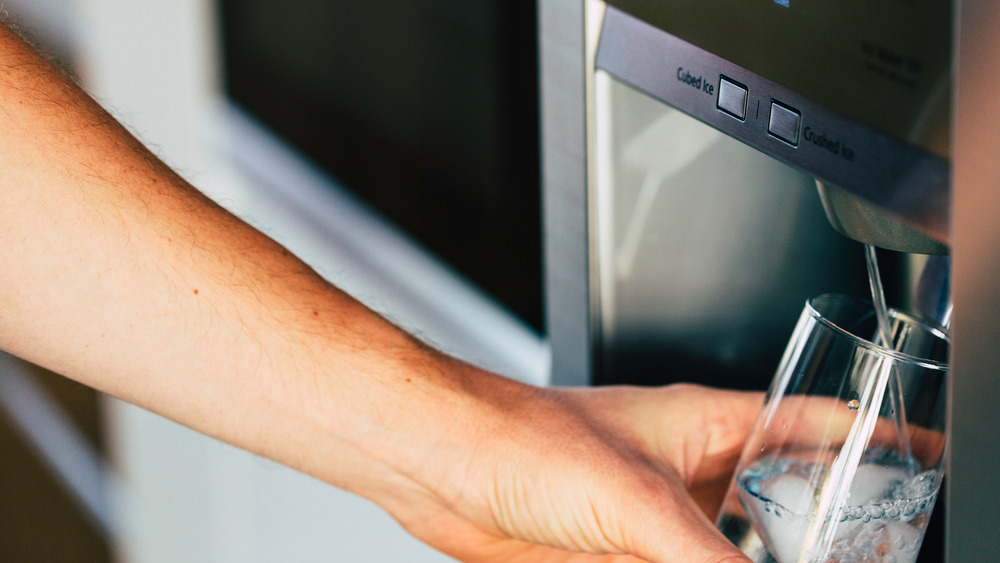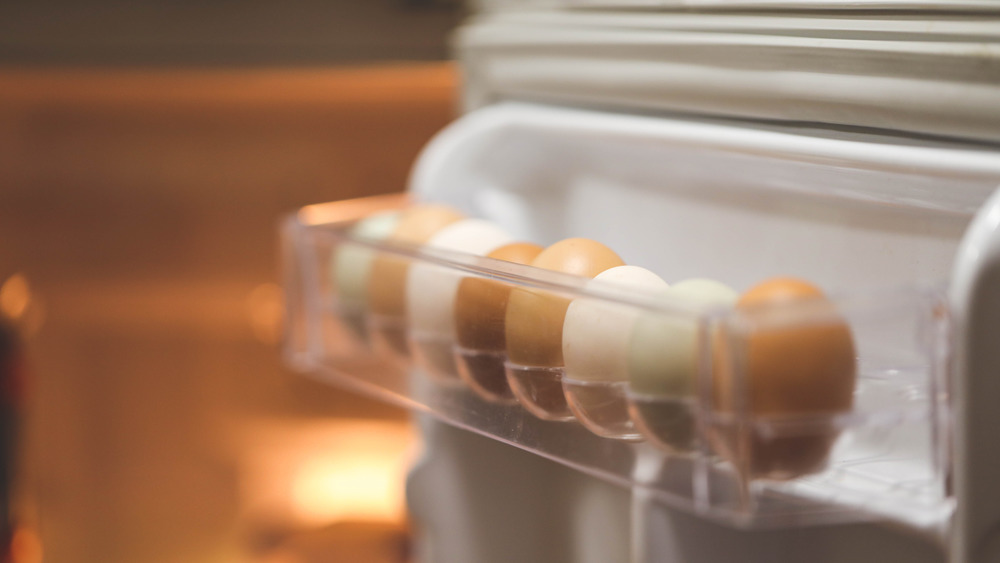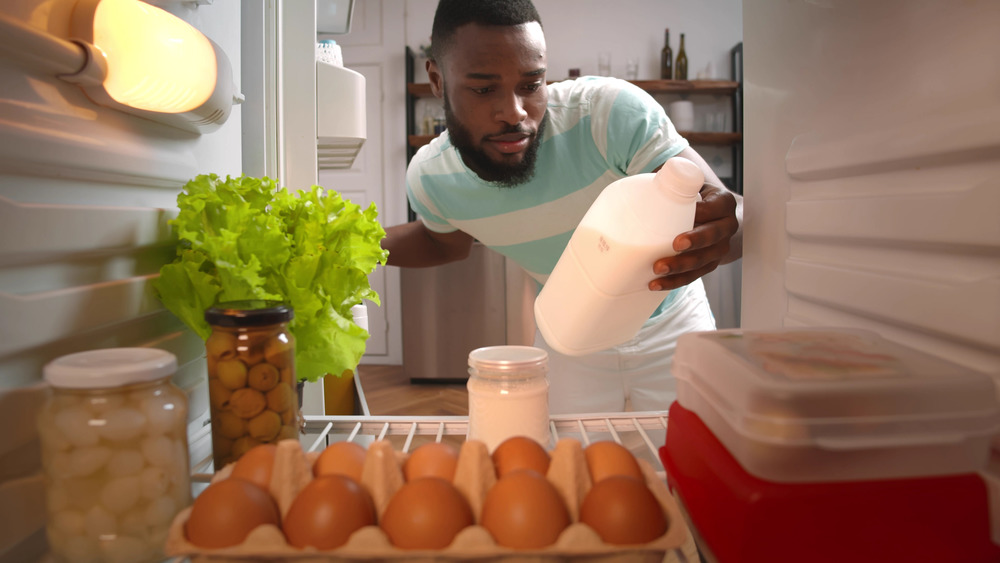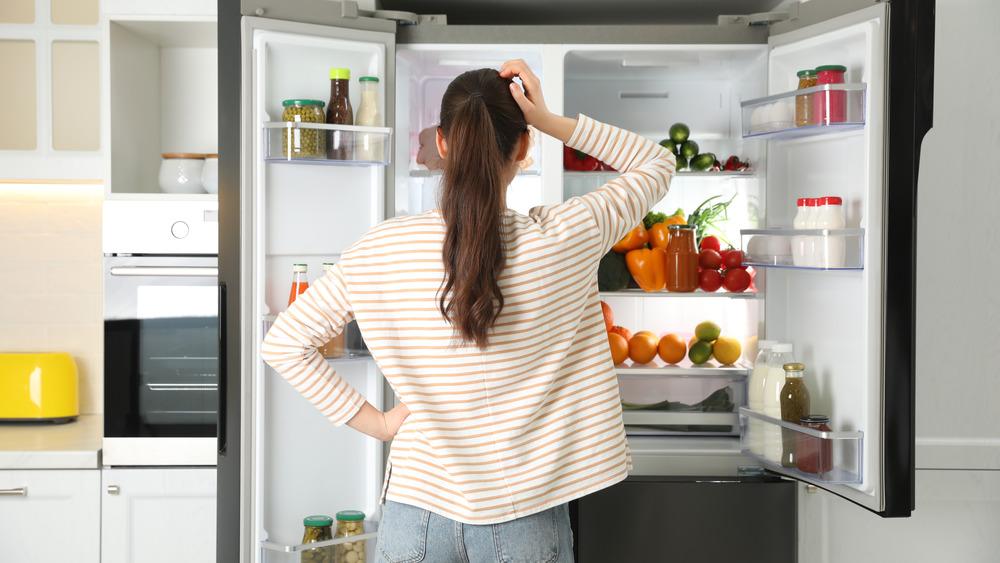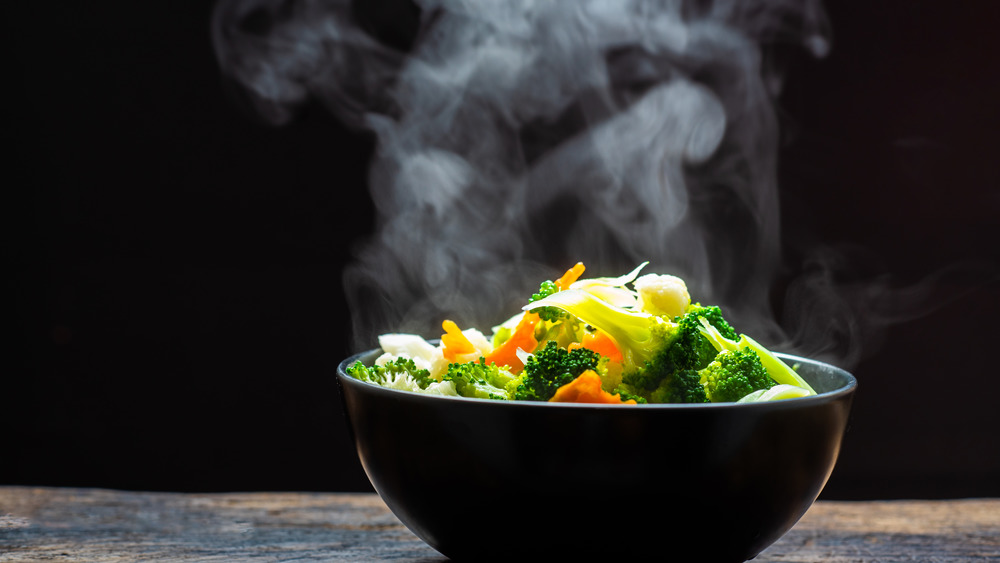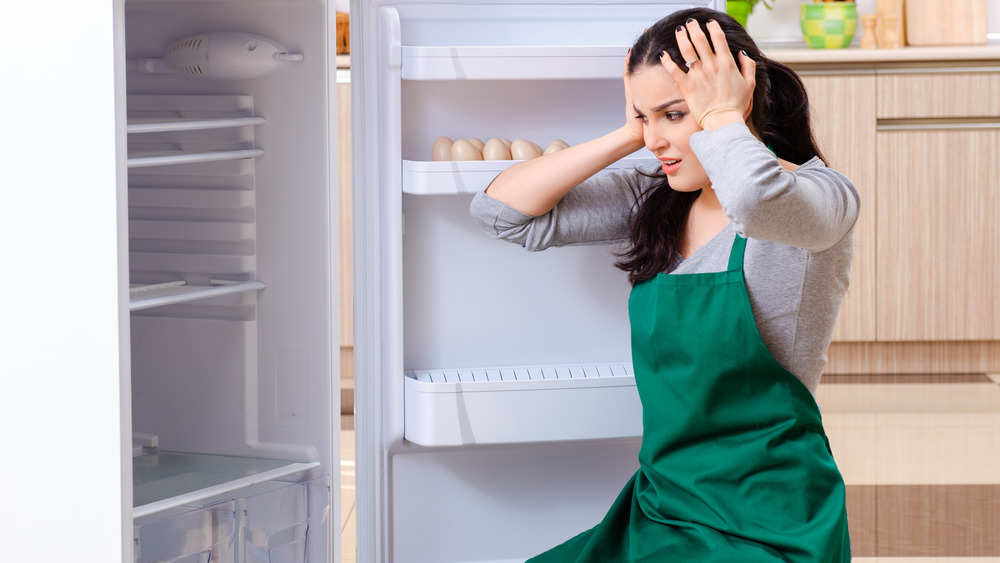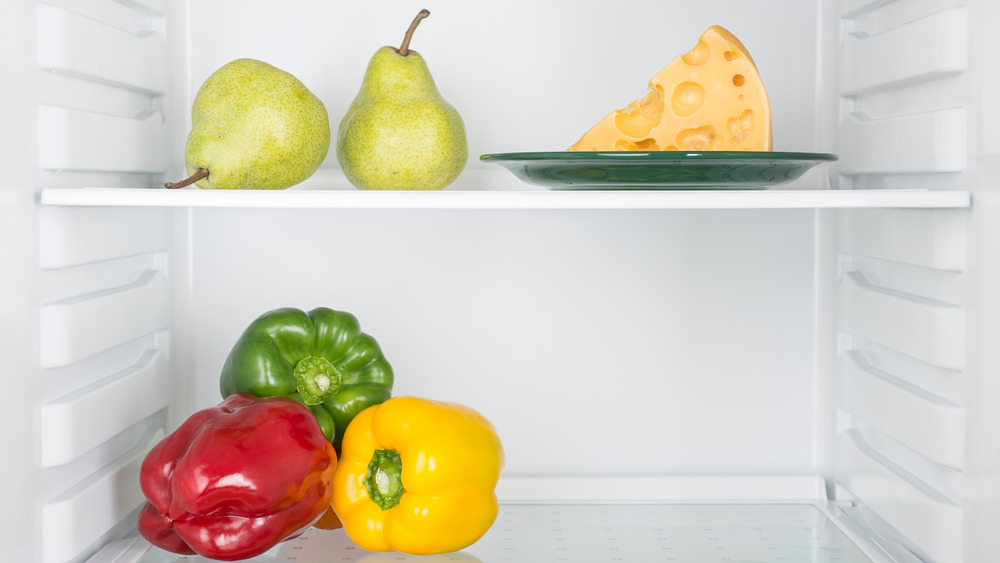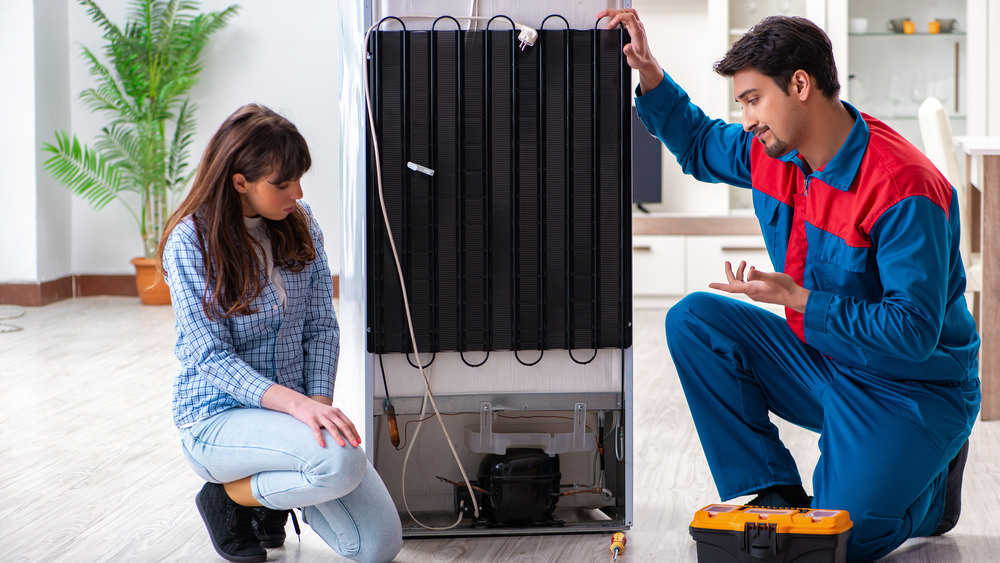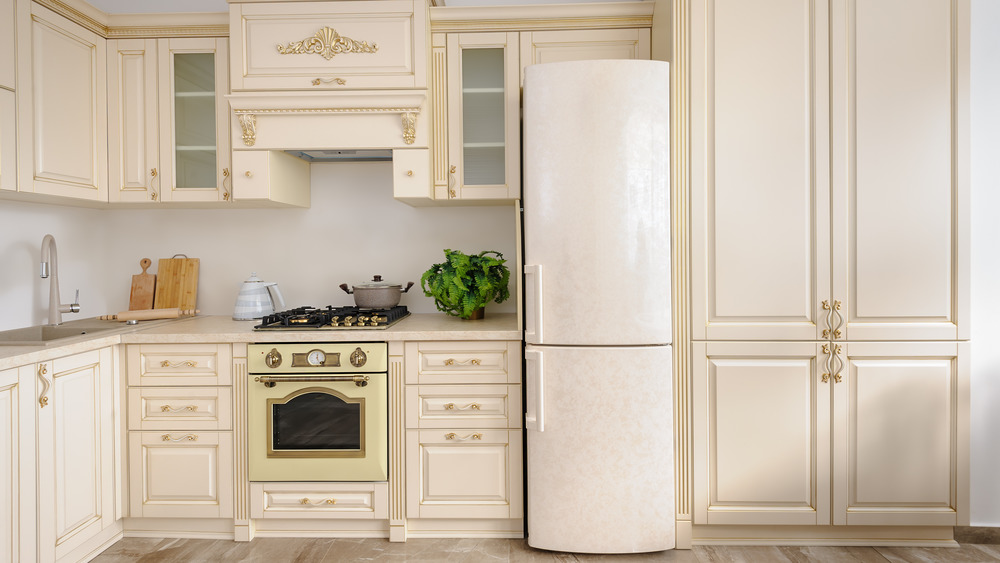Mistakes Everyone Makes With Their Refrigerator
Refrigerators are easy, right? Plug them in, open and close, keep things cold, and convince your little nieces and nephews that there's a teeny-tiny elf that lives inside and turns the light on and off. What could be more straightforward?
Only, it's not actually that simple, and it turns out there's a lot of things you can do wrong with a fridge. It's entirely possible that your day-to-day habits might be making your fridge less energy-efficient, or even more likely to spoil your food.
And that's a huge deal. According to Food Print, the average American household wastes about 21 percent of the food they buy. That works out to around 238 pounds each year, and in other words, that's about $1,800 right into the garbage. They also say that around two-thirds of that is due to food spoilage, which includes improper storage. How often do you peek into the fridge to grab a snack and find something you've forgotten about? Or something that's on the shelf and either too warm or too cold? It's all adding to the problem, but there's also much more.
There's good news — this is all easy to fix, so let's talk about what you're doing wrong with your fridge, and how to make it right.
You're over-filling the refrigerator
Sure, there's something satisfying about coming home from the grocery store and filling your fridge to the brim. It makes the meal choices seem almost endless, but filling it too full is actually a massive mistake.
According to Hunker, over-filling your fridge isn't just easy to do, but there's going to be several consequences that you might not notice, but your bank account will. Air circulation is a big part of what keeps everything in your fridge cool, and when there's too much stuff in it, you're blocking a lot of that circulation. That means the fridge needs to work harder to keep everything at the right temperature, especially if all that food is blocking some air vents. In turn, that means a higher energy bill.
In addition to higher energy bills, you might also be looking at some extra food spoilage as an over-full fridge means it's unlikely that everything's going to be chilled to the correct temperature. When it's not, that's when you're risking food spoilage or — worse — food poisoning.
On the other hand, you shouldn't keep your fridge too empty, either. Much of a fridge's cooling power comes from the fact that once items are cold, they can help keep other things cold, too. When it's mostly empty, that mechanism just doesn't work. Try to keep it full but not too full, and you'll be right on track.
You're not keeping the refrigerator cold enough
What temperature is your fridge set at? You might want to check, because there's a good chance it's wrong.
According to the Food & Drug Administration, your refrigerator temperature should be set at 40 degrees Fahrenheit or below. (For consistency's sake, they say your freezer should be at 0 degrees Fahrenheit.)
They say that you should also be checking your temps regularly to make sure everything's working A-okay, but it's entirely possible there's more to it. Real Simple says that the bacteria that causes food poisoning starts to multiply at temperatures of 40 degrees and above, so if you have your fridge set right at that threshold, you're sort of asking for disaster. Every time you keep the door open too long (and everyone does it), pile in some warmer groceries from a shopping trip, or put in some still-warm leftovers, you're really close to the danger zone.
Instead, try to keep your fridge a little colder — ideally, that's between 35 and 38 degrees. That'll keep everything above freezing (32 degrees Fahrenheit), and farther from the food spoilage, bacteria-building danger zone.
You're not changing the refrigerator's water filter
If your refrigerator also dispenses cold water and has an ice maker, there's an extra component of upkeep that you're likely to overlook: the water filter.
According to The Bolt, changing the water filter on your fridge on a regular basis — usually every three to six months, depending on the manufacturer's recommendation — is important for a few reasons. First, the more obvious one: contaminants. The point of the filter is to get rid of any questionable substances that might still be in your drinking water before it makes it to your glass, and the old "better safe than sorry" adage definitely applies to what's in your drinking water.
Secondly, not changing the filter can also shorten your fridge's lifespan. How? By promoting the buildup of deposits and limescale within the inner hoses and mechanisms of your water dispenser and ice maker, which can cause some major damage.
If you're not sure when you last changed the filter, it's probably a good time to do so. Paradise Appliance says there's some tell-tale signs to look for: in addition to off-color, murky, and funny-tasting or funny-smelling water, for starters. Also, the presence of black flecks can indicate the mesh that holds the charcoal inside the filter is breaking down, and it's ending up in the water. In that case, it's definitely time for a change.
You're using those refrigerator egg holders
Everyone has their habits, and if yours includes taking eggs out of their carton and putting them in the handy-dandy egg tray that comes with most fridges, you might want to rethink that.
Those egg trays may look convenient, but could be a recipe for food poisoning. When eggs are stored on the fridge door, regular opening and closing of the fridge means the temperature they're being stored at fluctuates. That's fine for some things, but when it comes to eggs, that increases the likelihood that they're going to spoil before their expiration date. Healthline says that eggs spoil — or rot — because of the bacteria in the white and the yolk. That bacteria grows when the egg gets to a temperature of 40 degrees Fahrenheit or above, and when you've got the door open and you're deciding what's for dinner, they're probably not as cold as they should be.
Instead, it's much safer to keep them in their container and stored on a shelf where the temperature is more consistent. It might not look as pretty, but it's definitely safer.
You're keeping dairy product in the refrigerator door
Pouring some spoiled milk in your coffee or eating a spoonful of bad yogurt for breakfast in the morning is a great way to ruin your day. And, while it might seem convenient to keep milk, cream, or yogurt on the door where it's within easy reach, that's actually the worst place you could put dairy.
The fridge door is the warmest place in the fridge for a few reasons. In addition to the regular opening and closing, it's also the part of the fridge that's most susceptible to temperature fluctuations that come from the rest of the kitchen — especially if you've got the stove or the oven going.
So, where should you keep it? It sounds inconvenient, but here's where the "don't overfill your fridge" rule comes in. Store milk on the bottom shelf toward the back of the fridge, where it's going to be colder. (Top shelves are generally warmer.) And that goes for other types of dairy, too. Milk, cream, yogurt, whipped cream, half & half ... they'll all last longer when they're safely tucked away in the coldest part of the fridge.
You're not putting food on the right refrigerator shelves
Do you have a set-in-stone way of stocking the fridge, or is it just sort of a willy-nilly mess of stuff that goes wherever it fits? If the answer is the latter, it should definitely be the former — and even if you have a system, it might not be the best for you.
Good Housekeeping did some experimentation to find the best way to organize your fridge, and they learned a few things. First, there are some places that certain foods should be kept based on temperature controls and levels of coldness. Dairy should be on the bottom in the back, and so should eggs. Condiments are less perishable, so they can go on the door, along with things like processed juices.
But for other things, you should take stock of your family's particular needs. If you have young children, for example, put the food items you want them to snack on at a convenient eye level. If you have a lot of bins in the fridge, make one for them — it'll save on searching and messes both in and out of the fridge. Figure out what you use most, and put them in spots that are easy to reach. And biggest of all: opt for clear containers, so you can immediately see what's inside. If you find a plan that works and stick with it, it'll make grabbing a snack or prepping dinner so much easier — and energy-efficient.
You're not cooling food safely before putting it in the refrigerator
You've heard the warnings: don't put hot food in the fridge. So, do you let things sit on the counter and cool completely before stowing leftovers in the fridge? It turns out, that's not entirely right, either.
The Washington State Department of Health says that yes, you can put food in the fridge before it's completely cooled — and you should.
The guidelines (via Michigan State University) are pretty straightforward, and for most foods (think of a leftover burger from dinner, or a bit of veg), you can safely put them in a small container and put them in the fridge right away.
It's a little more complicated if you've, say, made a giant pot of chili or soup. Then, proper cooling involves a two-step cooling process. In the first two hours after serving, your leftovers should be cooled from a cooking temperature of 140 to 70. (That changes if the temperature in your kitchen is above 90 degrees, and that time drops to just one hour.) You can do that by putting the leftovers in small, shallow containers, then cooling them in an ice bath. They don't need to be cold, though, just not smoking hot. Once they're down to 70 degrees, they can safely be packaged and put into the fridge to cool the rest of the way. Your leftovers won't spoil, and you won't compromise the safety of the other food in your fridge.
You're not cleaning your refrigerator well enough
Be honest: how often do you clean your fridge? It's one of those things that's easy to skip — out of sight, out of mind, after all. But if you put off deep cleaning your fridge for too long, the Australian Institute of Food Safety says you could be putting yourself and your family at risk for food poisoning.
Even if it looks clean, it might not be. There's a lot going in and out, after all, and here's some food for thought. Ideally, the amount of bacteria contamination (in units per square centimeter) should be between 0 and 10. When they looked at studies of what was found in most home fridges, they found an average of 7,850 bacteria per square centimeter. Yikes!
Good Housekeeping says that fridges should be getting a complete, top-to-bottom cleaning between every three and six months. That involves completely emptying it (and storing your food in a cooler with some ice packs), then removing drawers and shelves and washing them with hot, soapy water. (Let any glass parts come to room temperature first to prevent shattering.) Wipe the interior — and don't forget to clean in the crevices with a toothpick — and dry completely and cool before restocking.
You're keeping fruits and veggies in the refrigerator together
Fruits and vegetables might seem like they're the perfect grocery items to go next to each other in the fridge, or even in the same drawer. Surprisingly, though, putting them together might be a massive mistake.
According to The Kitchn, it all has to do with how fruit ripens and vegetables spoil. Most fruits — including common staples like apples, pears, peaches, and tomatoes — produce a gas called ethylene as part of their ripening process. Some fruits — like bananas and apples — will ripen faster when they're exposed to an external source of ethylene. It's why a bunch of bananas will ripen faster when they're in a bag than a single banana would on its own. But it also has an impact on how fast these foods spoil.
If you've ever heard the expression "one rotten apple will spoil the whole bunch," that's actually true. That ethylene isn't just responsible for ripening, it'll make fruits and vegetables rot faster, too. And, while fruits produce ethylene, it's vegetables that are highly sensitive to it. In other words, if you store fruits and veg together, your fruit is going to produce a ton of ethylene as it ripens, and your veg is going to react with that same ethylene and rot much faster than it would if it was stored separately.
You've never checked the refrigerator door seal
Here's something that probably isn't even on your radar as something that could malfunction: the door seal on your fridge.
According to c|net, many people might notice there's something wrong with the door seal when the door won't close right. There's a good chance it was a problem a long time in the making, though, and when the door seal on your fridge starts to go, that's letting cold air out, warm air in, and it's increasing the likelihood of spoilage at the same time it's increasing your energy bills.
Fortunately, there's an easy way to test the seal. With the fridge closed, check for any cold spots. If you find them, the seal is leaking. You can also spot small problems before they become big ones by opening the door, putting a piece of paper between the two halves of the door seal, and closing it. Try to pull the paper out. The Guardian says that there should be resistance there, and if you can pull the paper out easily, you've just found a weak spot in the gasket.
If you find weak spots, don't worry — there's good news. The process varies by make and model, but gaskets are fairly easy to replace.
You've never cleaned the refrigerator's coils
The what now? If that's the question you're asking, you've definitely gone too long without doing this one.
Bob Vila says that the refrigerator coils are what holds the coolant — and that, in turn, keeps the fridge doing exactly what it's supposed to. Those coils aren't tucked safely away, they're exposed to all the dust and dirt buildup that happens in every kitchen, no matter how diligent one might be about vacuuming. They're also easy to overlook, but in order to keep energy efficiency up and costs down, they should be cleaned at least once a year. (And that's every six months for families with pets who shed — and you know who you are.)
There's good news here, too: it's super easy. Just unplug the fridge and move it out from the wall. (This whole process will be quick, and there's no need to empty it.) Find the panel that hides the coils — or the exposed coils themselves — it'll be along the bottom. Grab a dust mask, and use a coil condenser brush (which you can pick up at any home improvement store) to loosen up the dust between the coils. Vacuum, and done!
The refrigerator's not in the right place
Granted, this will be a tough one to fix — but if you're moving into a new place or doing some kitchen remodeling, it's worth taking your fridge placement into consideration. Andi-Co Australia says that especially in hot, sunny climates, refrigerator location can be a big deal. Sure, it's insulated, but if your average temperature hovers around "hot and sunny" and your fridge spends 10 hours a day in the sun, it's going to lower efficiency and raise electricity bills.
Even if you're not in sunny California or Hawaii, heat sources can still be a concern, and fridges should never be directly across from stoves and ovens.
Available counter space near the fridge is also a must, as it means you'll spend less time with the door open. If you're in the market for a new fridge, pay attention to where your workspace is and make sure you get a fridge that opens in a way that's not going to block your movement — it's a little thing that's easy to overlook, but it's one that can cause a lot of buyer's remorse right from day one.
And finally, here's one that's easy to check even if you're not remodeling. Make sure your refrigerator has enough ventilation in the back, sides, and top. Mr. Appliance says that there should be between one and 1 inch of clearance on the top and side, and between one and two inches clearance at the back.

